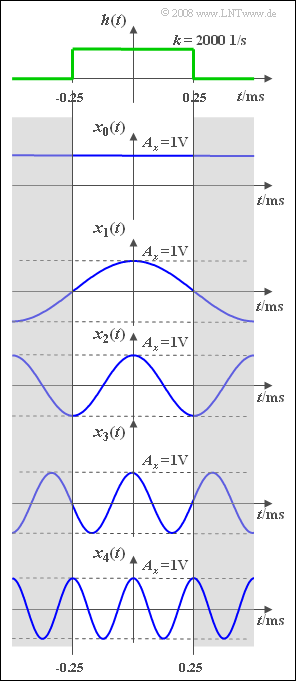Exercise 1.6Z: Interpretation of the Frequency Response
The task is to investigate the influence of a low-pass filter H(f) on cosinusoidal signals of the form
- xi(t)=Ax⋅cos(2πfit). In the graph you can see the signals xi(t), where the index i indicates the frequency in kHz . So, x2(t) describes a 2kHz–signal.
The signal amplitude in each case is Ax=1V. The direct (DC) signal x0(t) is to be interpreted as a limiting case of a cosine signal with frequeny f0=0.
The upper sketch shows the rectangular impulse response h(t) of the low-pass filter. Its frequency response is:
- H(f)=si(πf/Δf).
Due to linearity and the fact that H(f) is real and even the output signals are also cosine-shaped:
- yi(t)=Ai⋅cos(2πfit).
- The signal amplitudes Ai at the output for different frequencies fi are searched-for and the solution is to be found in the time domain only.
- This somewhat circuitous solution is intended to make the basic relationship between the time and frequency domains clear.
Please note:
- The exercise belongs to the chapter Some Low-Pass Functions in Systems Theory.
- Contrary to the usual definition of the amplitude, the "Ai" may well be negative. This corresponds then to the function „minus-cosine”.
Questions
Solution
(2) The (equivalent) time duration of the impulse response is Δt = 0.5 \ \rm ms. The equivalent bandwidth is equal to the reciprocal:
- Δf = 1/Δt \ \rm \underline{= \ 2 \ kHz}.
(3) Approaches 1 and 3 are correct:
- Da y_i(t) cosinusförmig ist, ist die Amplitude A_i = y_i(t = 0). Das Ausgangssignal wird hier über die Faltung berechnet:
- A_i = y_i (t=0) = \int\limits_{ - \infty }^{ + \infty } {x_i ( \tau )} \cdot h ( {0 - \tau } ) \hspace{0.1cm}{\rm d}\tau.
- Berücksichtigt man die Symmetrie und die zeitliche Begrenzung von h(t), so kommt man zum Ergebnis:
- A_i = \frac{A_x}{\Delta t} \cdot \int\limits_{ - \Delta t /2 }^{ + \Delta t /2 } {\rm cos}(2\pi f_i \tau )\hspace{0.1cm}{\rm d}\tau.
(4) Richtig sind die Lösungsvorschläge 2, 3 und 5:
- Beim Gleichsignal x_0(t) = A_x ist f_i = 0 zu setzen und man erhält A_0 = A_x \ \rm \underline{ = \ 1 \hspace{0.05cm} V}.
- Dagegen verschwindet bei den Cosinusfrequenzen f_2 = 2 \ \rm kHz und f_4 = 4 \ \rm kHz jeweils das Integral, da dann genau über eine bzw. zwei Periodendauern zu integrieren ist: A_2 \ \rm \underline{ = \hspace{0.05cm} 0} und A_4 \hspace{0.05cm} \rm \underline{ = \ 0}.
- Im Frequenzbereich entsprechen die hier behandelten Fälle:
- H(f=0) = 1, \hspace{0.3cm}H(f=\Delta f) = 0, \hspace{0.3cm}H(f=2\Delta f) = 0.
(5) Das Ergebnis der Teilaufgabe (3) lautet unter Berücksichtigung der Symmetrie für f_i = f_1:
- A_1= \frac{2A_x}{\Delta t} \cdot \int\limits_{ 0 }^{ \Delta t /2 } {\rm cos}(2\pi f_1 \tau )\hspace{0.1cm}{\rm d}\tau = \frac{2A_x}{2\pi f_1 \cdot \Delta t} \cdot {\rm sin}(2\pi f_1 \frac{\Delta t}{2} )= A_x \cdot {\rm si}(\pi f_1 \Delta t ).
- Mit f_1 · Δt = 0.5 lautet somit das Ergebnis:
- A_1 = A_x \cdot {\rm si}(\frac{\pi}{2} ) = \frac{2A_x}{\pi} \hspace{0.15cm}\underline{= 0.637\,{\rm V}}.
- Entsprechend erhält man mit f_3 · Δt = 1.5:
- A_3 = A_x \cdot {\rm si}({3\pi}/{2} ) = -\frac{2A_x}{3\pi} = -{A_1}/{3}\hspace{0.15cm}\underline{= -0.212\,{\rm V}}.
- Genau zu den gleichen Ergebnissen – aber deutlich schneller – kommt man durch die Anwendung der Gleichung:
- A_i = A_x · H(f = f_i).
- Bereits aus den Grafiken auf der Angabenseite erkennt man, dass das Integral über x_1(t) im markierten Bereich positiv und das Integral über x_3(t) negativ ist.
- Es ist allerdings anzumerken, dass man im Allgemeinen als Amplitude meist den Betrag bezeichnet (siehe Hinweis auf der Angabenseite).
